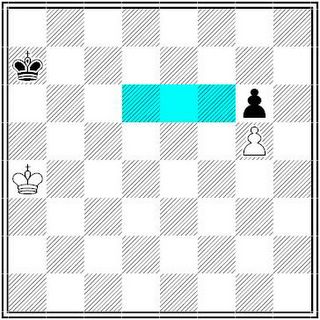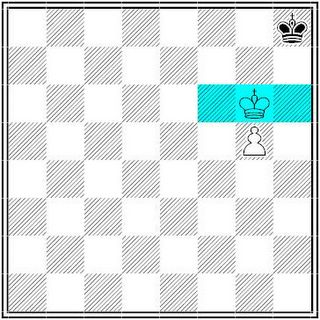Invisible patterns
To give you an idea of how SOPE works.
In the book they use a lot of diagrams where key squares, critical squares, winning/drawing/losing sectors, corresponding squares are shown.
A key square is a square that quarantees succes (in your marriage and OTB), no matter who is to move.
See for an example of key squares diagram 1.
They make use of symbols in stead of colours.

Diagram 1. White to move.
If white manages to conquer a key square, he will capture the black pawn.
At that moment he stands already on a new key square.
One which assures the promotion of the pawn.
See diagram 2.

Diagram 2. Black to move, white to win.
Without the book it costed me hours per problem to figure out where those fields are in any given position. I simply had not the knowledge. I even figured out (part of) the theory of corresponding squares myself. Which is a waste of time.
If you know exactly where your king has to head for, things become much easier.
In the endgame the importance to see the invisible patterns is very clear.
The same however is true for the middlegame.
The concentric squares and knightforks of the DLM program lead simple to "the popping out of the invisible".
I'm sure that a lot of my problems in the middlegame are caused by my habit to look at the pieces in stead of to the squares they cover.
This "chess vision" of DLM has a scientific base.
Research of the eye movements of amateurs and grandmasters has shown that the eyes of the latter are focussed more still between the pieces, while the eyes of the amateur are running around from piece to piece.
SOPE busy with chapter 3.
circle 1. 50 done, 368 to go.
In the book they use a lot of diagrams where key squares, critical squares, winning/drawing/losing sectors, corresponding squares are shown.
A key square is a square that quarantees succes (in your marriage and OTB), no matter who is to move.
See for an example of key squares diagram 1.
They make use of symbols in stead of colours.

Diagram 1. White to move.
If white manages to conquer a key square, he will capture the black pawn.
At that moment he stands already on a new key square.
One which assures the promotion of the pawn.
See diagram 2.

Diagram 2. Black to move, white to win.
Without the book it costed me hours per problem to figure out where those fields are in any given position. I simply had not the knowledge. I even figured out (part of) the theory of corresponding squares myself. Which is a waste of time.
If you know exactly where your king has to head for, things become much easier.
In the endgame the importance to see the invisible patterns is very clear.
The same however is true for the middlegame.
The concentric squares and knightforks of the DLM program lead simple to "the popping out of the invisible".
I'm sure that a lot of my problems in the middlegame are caused by my habit to look at the pieces in stead of to the squares they cover.
This "chess vision" of DLM has a scientific base.
Research of the eye movements of amateurs and grandmasters has shown that the eyes of the latter are focussed more still between the pieces, while the eyes of the amateur are running around from piece to piece.
SOPE busy with chapter 3.
circle 1. 50 done, 368 to go.
I'm going to buy this book on your reommendation.
ReplyDeleteMy post-circles training has just begun. Invisible patterns will play a key role. Key squares: Very useful indeed! I did know the 3 squares in front of the pawn already. When King has not yet reached 6th rank, they are 2 ranks in front of the Pawn. But I did not know the 3 on side of the Pawn. Great stuff. But I have to postpone the whole endgame business in favour of vision and thinking drills. Could also be called blunder prevention drills.
ReplyDeleteHmmmm...yet another one on my todo list now (*cry*).
ReplyDelete